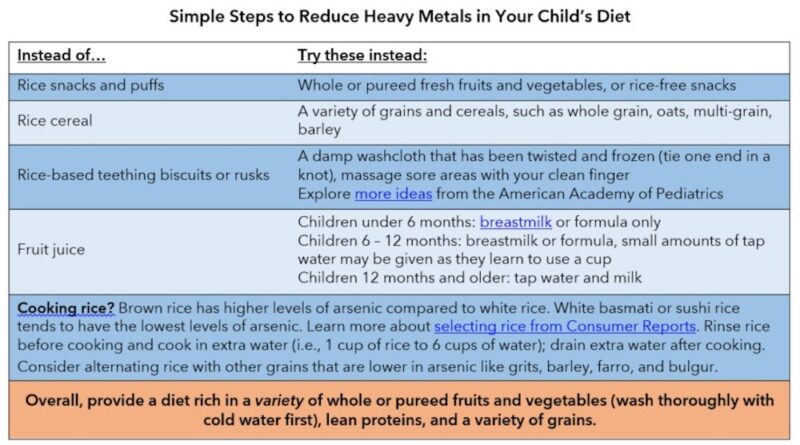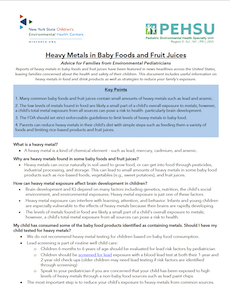Reports of heavy metals in baby foods and fruit juices have been featured in news headlines across the United States, leaving families concerned about the health and safety of their children. Our website provides useful information on heavy metals in food and drink products as well as strategies to reduce your family’s exposure.
A heavy metal is a kind of chemical element – such as lead, mercury, cadmium, and arsenic. Heavy metals can occur naturally in soil used to grow food, or can get into food through pesticides, industrial processing, and storage. This can lead to small amounts of heavy metals in some baby food products such as rice-based foods, vegetables (e.g., sweet potatoes), and fruit juices.
Brain development and IQ depend on many factors including genetics, nutrition, the child’s social environment, and environmental exposures. Heavy metal exposure is just one of these factors. Heavy metal exposure can interfere with learning, attention, and behavior. Infants and young children are especially vulnerable to the effects of heavy metals because their brains are rapidly developing. The levels of metals found in food are likely a small part of a child’s overall exposure to metals; however, a child’s total metal exposure from all sources can pose a risk to health.
- Reduce exposure to lead: The most common source of lead exposure is peeling paint in homes built before 1978. Other sources include some imported spices and cosmetics, water, and some hobbies/occupations. Learn more about lead poisoning prevention here. All children should be screened for lead exposure with a blood test at their 1-year and 2-year old check ups.
- Reduce exposure to mercury: The most common source of mercury exposure is eating large predator fish. Since fish are an important part of a healthy diet, eat fish but choose wisely to limit mercury.
- Reduce exposure to arsenic: To reduce arsenic in your child’s diet, limit consumption of rice-based foods. If you have well water, ask your local health department if arsenic testing is needed (arsenic is a natural soil contaminant in some areas and can get into well water).
The table below provides simple steps for reducing heavy metals in your child’s diet.
- We do not recommend heavy metal testing for children based on baby food consumption.
- Lead screening is part of routine well child care:
- Children 6 months to 6 years of age should be evaluated for lead risk factors by pediatrician
- Children should be screened for lead exposure with a blood lead test at both their 1-year and 2-year old check-ups (older children may need a lead test if risk factors are identified through screening)
- Speak to your pediatrician if you are concerned that your child has been exposed to high levels of heavy metals through a non-baby food sources such as lead paint chips
- The most important step is to reduce your child’s exposure to heavy metals from common sources.
- The Food and Drug Administration (FDA) and food industry have taken steps to reduce heavy metals in baby food.
- Healthy Babies Bright Futures is a coalition of scientists, health professionals, and community-based organizations working together to support programs and policies that will reduce children’s exposure to toxins.
- An important next step is for the FDA to set health-based enforceable limits on heavy metals in baby foods and routinely monitor for compliance.
Althea Bickley from NYSCHECK talks about recent reports on heavy metals in baby food and what concerned parents should know.
Heavy Metals in Baby Food and Fruit Juice: Advice for Parents from Environmental Pediatricians (PDF)
American Academy of Pediatrics (AAP):
Heavy metals in baby food
Healthy Babies Bright Futures:
2019 Report- What’s in my Baby Food?


